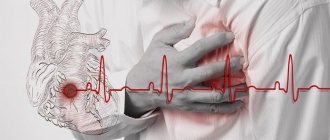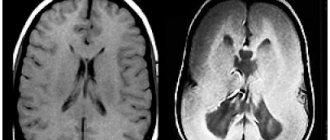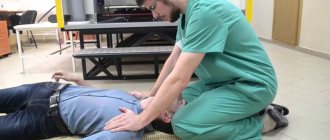Causes of fainting
A general feeling of weakness is a very common symptom of autonomic nervous disorder. The feeling of weakness can be chronic (chronic fatigue syndrome) or appear suddenly during everyday physical and psycho-emotional stress. A person suddenly experiences instability, dizziness, nausea and other symptoms of an autonomic disorder, depending on the degree of its neglect. This happens because the autonomic nervous system experiences difficulties in functioning and has difficulty adapting the body to the slightest load.
The essence of the syndrome and features of its appearance
The nervous system has a structure consisting of somatic and autonomic components.
The first is responsible for motor reactions that arise under the influence of external factors. The vegetative part is involved in the work of internal organs, blood vessels and glands, which is described in scientific articles about VSD and the websites of clinics licensed to treat it. The autonomic system is usually divided into sympathetic and parasympathetic fragments. The first part is responsible for increasing activity and stimulating metabolism. This leads to increased tissue excitability. The parasympathetic system restores the body and regulates its functions during sleep.
They are distinguished by synchronous recovery. However, under the influence of external conditions, a dominant is formed, and a predominance of a certain department is observed. Mental adaptation is disrupted, the emotional state suffers.
Vegetovascular dystonia (VSD) is a combination of manifestations that appear when there are interruptions in the functioning of the autonomic part of the nervous system. The disease causes various abnormalities in the functioning of internal organs.
This syndrome has different names - neurocirculatory dystonia, autonomic dysregulation, autonomic neurosis, neurasthenia.
Presyncope: Cases from practice
Female, 22 years old, HR manager.
In 2011, a young girl contacted us. During minor psycho-emotional stress, she often experienced faintness, general weakness, and drowsiness. There was a feeling that she was “about to faint,” but she never completely lost consciousness.
With little physical activity (rising to her feet, turning her body), instability and dizziness, and a feeling of loss of consciousness also occurred. I felt like “the blood was leaving my head to my feet.” I was looking for something for support. I was forced to control my every movement while walking.
The patient also complained of an unreasonable increase in heart rate and sleep disturbance: from time to time she could not fall asleep for a long time at night for no apparent reason.
At first, the patient associated the symptoms of the disease with a drop in blood pressure, but it, as a rule, turned out to be normal or even elevated. The condition of the blood vessels was also normal.
It is obvious that the autonomic nervous system, being in a “shaken” state, did not adapt the processes occurring in the body to minimal physical activity and, even more so, to more complex psycho-emotional stressful situations. The autonomic department of the nervous system did not rebuild the blood vessels instantly and worked at a slow pace. Therefore, such a pathological condition arose.
After one course of treatment, the girl felt much better and did not need repeated treatment.
Woman, 42 years old, translator.
The patient has a history of episodes of dizziness, nausea, and lightheadedness since adolescence. Rare fainting occurred during school, and after a long break, it recurred at the age of 22 and 23 due to stressful situations.
The woman contacted us in 2011. Since 2008, she began to complain of general poor health due to psycho-emotional stress. She experienced a feeling of unsteadiness when walking, dizziness and heaviness in her head.
A few months later, the condition began to gradually worsen: noise in the ears appeared, at times vision decreased: a “veil” appeared before the eyes, a feeling of loss of consciousness arose, waves of heat or cold rolled in. Approximately once a month, the condition worsened sharply: the feeling of nausea reached the point of vomiting.
The woman drew attention to the dependence of her condition on changes in weather factors (meteodependence), as well as on being in a stuffy room.
At the Center for Autonomic Neurology, the patient underwent two full courses of treatment. After the first course, I noted a 70% improvement in my condition. Carrying out a repeat course eliminated all remaining complaints.
What is a tension headache?
This type of headache occurs in 80% of people. It is quite easy to determine. The main difference between tension headaches is aching pain, a feeling of strong compression of the head. A characteristic feature of tension headaches is that they occur regardless of the time of day. However, it reminds itself most often after lunch.
It can be recognized by the following symptoms:
- In most cases, pain is felt in the forehead, temples, and back of the head.
- Has a pressing character.
- Sometimes it causes loss of appetite, less often it causes disruption of the stomach and intestines.
- The pain does not get worse during physical activity.
- Very often people complain that they feel a lot of pressure, but not pain.
- If you palpate, the person will complain of pain in the muscles of the neck and head.
In turn, HDN is divided into 2 types:
- Episodic. Almost always occurs after stress and is of moderate intensity. It usually goes away without specific treatment or is quite easily treated with conventional painkillers.
- Chronic. It is associated with systematic psycho-emotional stress, depression, and anxiety. Chronic tension headache can be recognized by characteristic pressing and squeezing sensations in the cloudy-occipital localization.
VSD in faces
This page contains excerpts from patient histories, covering the main complaints with which people turn to us for help. This is done with the goal of showing how different and “complex” the symptoms of vegetative-vascular dystonia can be. And how closely it is sometimes “fused” with disturbances in the functioning of organs and systems. How it “disguises” itself as “heart”, “pulmonary”, “stomach”, “gynecological” and even “psychiatric” problems that people have to live with for years...
To learn more
Vegetative-vascular dystonia: symptoms, diagnosis, treatment
Are you worried about pain in the heart area? Having trouble taking a breath? Feeling dizzy? Are your hands shaking and your stomach churning?
Neither an ECG, nor an MRI, nor all kinds of tests revealed any serious pathology. Is the patient really a malingerer?
Not at all. Everything he feels is real. The disorder that we will discuss today has more than a hundred manifestations. However, often (not always, but often) an attempt to find its “material” basis is unsuccessful.
With questions about what vegetative-vascular dystonia is and how to treat it, we went to see a neurologist, leading specialist in the neurology department of the Expert Clinic Kursk, Natalya Vladimirovna Umerenkova.
- Natalya Vladimirovna, many have heard the name “vegetative-vascular dystonia”. But does such a diagnosis really exist from the point of view of world medicine?
No. This formulation is found exclusively in the post-Soviet space. Of course, this does not mean that patients are making up their complaints - they are very real. However, formally, in the form of a diagnosis, VSD does not exist.
Does osteochondrosis exist? Radiologist at MRI Expert Elets says:
Yavorsky Evgeniy Valerievich
- What symptoms are they talking about when they mean vegetative-vascular dystonia?
Figuratively speaking, it is probably easier to name signs that do not occur in vegetative-vascular dystonia.
Essentially speaking, there are about 150 manifestations that may indicate the presence of VSD.
Conventionally, they can be divided into symptoms from the cardiovascular system (lowering or increasing blood pressure, discomfort or pain in the heart area, a feeling of “interruptions” in the heart, a feeling of tightness in the chest, headaches, dizziness), the respiratory system (a feeling of lack of air, inadequate inhalation or exhalation).
It's off scale! We are looking for the causes of high blood pressure. Read here
Numbness of the skin around the mouth also occurs; numbness and coldness of the hands and feet; general weakness, lethargy, fatigue; increased sweating; a slight increase in body temperature (slightly above 37°C), which cannot be explained by any other disease; urination and sexual dysfunction. From the gastrointestinal tract, pain, nausea, impaired intestinal motor function, and a feeling of “fullness” in the upper abdomen may be observed.
- What diseases can be hidden under what is called vegetative-vascular dystonia?
Variety. This may be coronary heart disease, hypertension, pathologies of the thyroid gland in the form of weakening or strengthening of its function, problems of the digestive system (gastritis, biliary dyskinesia), organic damage to the central nervous system (pathology of the hypothalamus), diseases of the adrenal glands, diseases of the urinary tract (cystitis). ), neurotic and psychotic disorders and others.
What is hypothyroidism of the thyroid gland? The endocrinologist at the Expert Clinic Borisoglebsk, Olga Arkadyevna Kalinina, tells
- Neurocirculatory dystonia and vegetative-vascular dystonia - are they the same thing or different?
Yes, VSD and NDC are, in principle, the same thing.
- What should a patient do if the doctor said that he has “vegetative-vascular dystonia”: look further for a diagnosis or live with VSD?
Depends on whether the patient has already been examined before or not. Vegetative-vascular dystonia is, as a rule, not a “first appointment” diagnosis. As we already know, this formulation may hide very real ailments. Therefore, a full examination of the patient is necessary to exclude these diagnoses. And if after this no existing diagnosis can be established - due to the lack of sufficient criteria - we can talk about the presence of autonomic disorders.
It hurts, but there is no diagnosis. Read here
- What are the reasons for the development of vegetative-vascular dystonia? What causes this condition?
The autonomic nervous system consists of two large divisions - sympathetic and parasympathetic. Without going into details, we can say that the “directions” of these two systems are opposite, i.e. they have an antagonistic effect on various body functions. Normally, they are in a state of equilibrium with respect to each other.
In some situations (for example, chronic disease, intoxication, etc.), the “coherence” of the work of these departments is disrupted. Often the sympathetic nervous system begins to predominate (it is more variable and sensitive). In response to some excess load, a disproportionate response of this department occurs in the form of excessive reactions, symptoms that are regarded by the patient as abnormal and frightening.
In addition, this complex involves the hypothalamus and the so-called limbic system (it is responsible, in particular, for emotions), which perform a kind of integrating function. When the functions of this complex are disrupted, the result is something resembling an “orchestra without a conductor,” i.e. each participant begins to function in his own way. In other words, normally, when the patient might not feel, say, certain fluctuations in blood pressure, in conditions of vegetative imbalance it begins to be perceived differently, sometimes with emotional “coloring” (fear, anxiety).
- Natalya Vladimirovna, how is vegetative-vascular dystonia confirmed or refuted? What diagnostics should a patient with suspected VSD undergo?
It depends on the type of complaint. If, for example, this is a rapid heartbeat or “interruptions” in the work of the heart, fluctuations in blood pressure, then a set of studies will be appropriate, i.e. this could be an ECG, Holter monitoring, echocardiography, a certain set of laboratory tests (clinical blood test, urine test, study of thyroid hormones).
If there are complaints from the respiratory system, fluorography, examination of external respiration function, and some tests will be advisable.
Why are x-rays dangerous? Yulia Aleksandrovna Rutskaya, head of the radiology department of the Expert Clinic Kursk, tells
If there are manifestations from the gastrointestinal tract, then these are endoscopic studies (gastroduodenofibroscopy, colonoscopy, ultrasound of the abdominal organs, a number of biochemical blood tests).
Where can I find the courage to make up my mind? Gastroscopy – WITHOUT fear! Read here
If there are signs of a possible pathology of the urinary system, an ultrasound of the kidneys and bladder, a general urine test, a biochemical blood test with determination, in particular, of urea, creatinine, etc. are prescribed.
Some patients may be prescribed a consultation with a psychotherapist - for example, when a doctor, during a conversation with a patient, discovers that complaints are “blurred”, when they are difficult to attribute to a particular area or system of the body. Diseases in which complaints and other manifestations affect many systems certainly exist, but a connection between the subjective feeling of malaise exclusively and the psyche cannot be ruled out. Therefore, an examination by a psychotherapist may be required; there is nothing wrong with that.
- What specialty does the doctor treat the symptoms of VSD?
This is the competence of a neurologist and psychotherapist, and, if necessary, a psychiatrist.
You can make an appointment with a neurologist here
Please note: the service is not available in all cities
- What are the principles of treatment of vegetative-vascular dystonia?
You should always remember that VSD is a benign disorder that can be eliminated by optimizing your lifestyle, proper work and rest schedule, and sufficient sleep. To eliminate its manifestations, medications of various classes are used - in particular, some types of antidepressants and anti-anxiety drugs. Treatment is often complemented by psychotherapy, which in some cases is the main type of treatment.
For reference:
In 2004 she graduated from Kursk State Medical University.
In 2004-2005, she completed an internship in neurology at the above-mentioned university.
Since 2015, he has been working at Clinic Expert Kursk LLC, and is a leading specialist in the neurology department.










